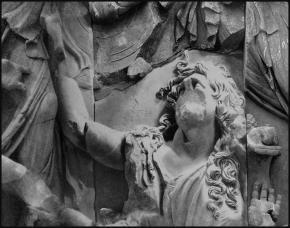One's History is Another's Misery
25 Jul - 06 Sep 2009
ONE'S HISTORY IS ANOTHER'S MISERY
With Leo Asemota, Van Brummelen / De Haan, Jeremiah Day, Gert Jan Kocken, Sarah Ortmeyer
The 19th century myth of national identity is experiencing an important resurgence in the West and certainly in The Netherlands, which is wrestling with the introduction and deployment of a national historical canon and the founding of a National Historical Museum. But what a nation state embodies in symbolism and collective identity generally also has a negative version for those who stand outside it. The works in the exhibition One's History is Another's Misery focus attention on specific histories and events that are part of national identities and which have this reverse side, positive or negative, integral to them. The artists involved work from a documentary oriented, investigative attitude in which analytic images, lifted out of the flow of events, have a particular dramatic effect. At the same time, complying with Salman Rushdie's motto, "If history creates complexities, let us not try to simplify them," they often add an extra layer on top of the enormously complex and ambivalent histories that they lay bare.
Leo Asemota, originally from Nigeria, shows drawings, collages and a recording of the 2008 performance The longMarch of Displacement. In these he reflects on the role that the British empire played in the former kingdom of Benin (now Nigeria), and specifically on the relation between the celebrations surrounding Queen Victoria's Diamond Jubilee in London in 1897 and the punitive British expedition that was simultaneously taking place in Benin. From this perspective a plaque marking Victoria?s 60 years on the throne, at the foot of St. Paul?s Cathedral, comes to be seen in the light of the violent extinction of that once so famous African kingdom.
With Leo Asemota, Van Brummelen / De Haan, Jeremiah Day, Gert Jan Kocken, Sarah Ortmeyer
The 19th century myth of national identity is experiencing an important resurgence in the West and certainly in The Netherlands, which is wrestling with the introduction and deployment of a national historical canon and the founding of a National Historical Museum. But what a nation state embodies in symbolism and collective identity generally also has a negative version for those who stand outside it. The works in the exhibition One's History is Another's Misery focus attention on specific histories and events that are part of national identities and which have this reverse side, positive or negative, integral to them. The artists involved work from a documentary oriented, investigative attitude in which analytic images, lifted out of the flow of events, have a particular dramatic effect. At the same time, complying with Salman Rushdie's motto, "If history creates complexities, let us not try to simplify them," they often add an extra layer on top of the enormously complex and ambivalent histories that they lay bare.
Leo Asemota, originally from Nigeria, shows drawings, collages and a recording of the 2008 performance The longMarch of Displacement. In these he reflects on the role that the British empire played in the former kingdom of Benin (now Nigeria), and specifically on the relation between the celebrations surrounding Queen Victoria's Diamond Jubilee in London in 1897 and the punitive British expedition that was simultaneously taking place in Benin. From this perspective a plaque marking Victoria?s 60 years on the throne, at the foot of St. Paul?s Cathedral, comes to be seen in the light of the violent extinction of that once so famous African kingdom.

